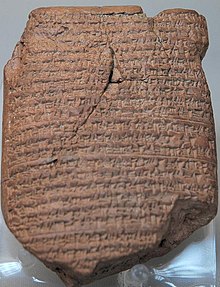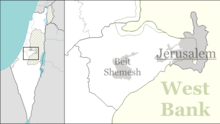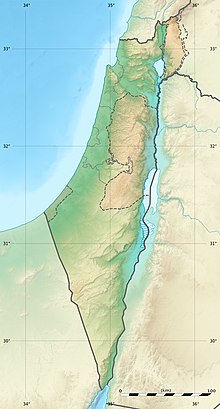| Revision as of 07:02, 23 January 2022 editTombah (talk | contribs)Extended confirmed users4,647 edits →Siege: Added linksTags: Mobile edit Mobile app edit Android app edit← Previous edit | Revision as of 16:34, 28 January 2022 edit undoAbune (talk | contribs)Extended confirmed users, Pending changes reviewers31,769 editsNo edit summaryNext edit → | ||
| Line 9: | Line 9: | ||
| |date = c. 597 BC | |date = c. 597 BC | ||
| |place = ] | |place = ] | ||
| | coordinates = {{WikidataCoord|display=it}} | |||
| | map_type = Israel jerusalem#Israel | |||
| | map_relief = y | |||
| | map_size = | |||
| | map_marksize = | |||
| | map_caption = | |||
| | map_label = | |||
| | map_mark = | |||
| | casus = | |||
| | territory = | |||
| |result = Babylonian victory<br>Babylon takes and despoils Jerusalem | |result = Babylonian victory<br>Babylon takes and despoils Jerusalem | ||
| |combatant1 = ] | |combatant1 = ] | ||
Revision as of 16:34, 28 January 2022
Military campaign carried out by Nebuchadnezzar II, king of Babylon, in 597 BC This article is about the siege that occurred in 597 BC. Not to be confused with the second siege by Nebuchadnezzar, see Siege of Jerusalem (587 BC). For other uses, see Siege of Jerusalem.| Siege of Jerusalem | |||||||
|---|---|---|---|---|---|---|---|
| Part of Jewish–Babylonian war (601–587 BC) | |||||||
 The siege of Jerusalem is mentioned in the Early Years of Nebuchadnezzar chronicle (ABC 05) | |||||||
| |||||||
| Belligerents | |||||||
| Judah | Neo-Babylonian Empire | ||||||
| Commanders and leaders | |||||||
|
Jehoiakim † Jeconiah | Nebuchadnezzar II | ||||||
| Strength | |||||||
| Much fewer | Unknown | ||||||
| Casualties and losses | |||||||
| Many slain, others taken to captivity | Unknown | ||||||
  | |||||||
| The Bible and warfare | ||||||||||||
|---|---|---|---|---|---|---|---|---|---|---|---|---|
| Hebrew Bible battles |
|  | ||||||||||
| Bible Portal | ||||||||||||
| Campaigns of Nebuchadnezzar II | |
|---|---|
| Part of a series on | ||||||||||||||||||||
| Jerusalem | ||||||||||||||||||||
|---|---|---|---|---|---|---|---|---|---|---|---|---|---|---|---|---|---|---|---|---|
 | ||||||||||||||||||||
|
||||||||||||||||||||
Sieges
|
||||||||||||||||||||
| Places | ||||||||||||||||||||
|
|
||||||||||||||||||||
| Political status | ||||||||||||||||||||
| Other topics | ||||||||||||||||||||
The siege of Jerusalem was a military campaign carried out by Nebuchadnezzar II, king of Babylon, in 597 BC. In 605 BC, he defeated Pharaoh Necho at the Battle of Carchemish, and subsequently invaded Judah. According to the Nebuchadnezzar Chronicle, King Jehoiakim of Judah rebelled against Babylonian rule, but Nebuchadnezzar captured the city and installed Zedekiah as ruler.
Siege
To avoid the destruction of Jerusalem, King Jehoiakim of Judah, in his third year, changed his allegiance from Egypt to Babylon. He paid tribute from the treasury in Jerusalem, some temple artifacts and some of the royal family and nobility as hostages. In 601 BC, during the fourth year of his reign, Nebuchadnezzar unsuccessfully attempted to invade Egypt and was repulsed with heavy losses. The failure led to numerous rebellions among the states of the Levant which owed allegiance to Babylon, including Judah, where King Jehoiakim stopped paying tribute to Nebuchadnezzar and took a pro-Egyptian position.
Nebuchadnezzar soon dealt with these rebellions. According to the Nebuchadnezzar Chronicle, he laid siege to Jerusalem, which eventually fell in 597 BC. The Chronicle states:
In the seventh year in the month Chislev the king of Babylon assembled his army, and after he had invaded the land of Hatti (Syria/Palestine) he laid siege to the city of Judah. On the second day of the month of Adar he conquered the city and took the king prisoner. He installed in his place a king of his own choice, and after he had received rich tribute, he sent forth to Babylon.
Jehoiakim died during the siege, possibly on December 10, 598 BC, or during the months of Kislev, or Tevet. Nebuchadnezzar pillaged the city and its Temple, and the new king Jeconiah, who was either 8 or 18, and his court and other prominent citizens and craftsmen, were deported to Babylon. The deportation occurred prior to Nisan of 597 BC, and dates in the Book of Ezekiel are counted from that event.
Nebuchadnezzar installed Jeconiah's uncle, Zedekiah as puppet-king of Judah, and Jeconiah was compelled to remain in Babylon. The start of Zedekiah's reign has been variously dated within a few weeks before, or after the start of Nisan 597 BC.
Chronological note
The Babylonian Chronicles, which were published by Donald Wiseman in 1956, establish that Nebuchadnezzar captured Jerusalem the first time on March 16, 597 BC. Before Wiseman's publication, E. R. Thiele had determined from the biblical texts that Nebuchadnezzar's initial capture of Jerusalem occurred in the spring of 597 BC, but other scholars, including William F. Albright, more frequently dated the event to 598 BC.
Biblical account
The siege is described in 2 Kings 24:10–16 in the Old Testament. The deportation was the start of the exile and of the Jewish Diaspora.
References
- C. Hassell Bullock (May 2007). An Introduction to the Old Testament Prophetic Books. p. 340. ISBN 9781575674360.
- The Divided Monarchy c. 931–586 BC
- Geoffrey Wigoder, The Illustrated Dictionary & Concordance of the Bible Pub. by Sterling Publishing Company, Inc. (2006)
- No 24 WA21946, The Babylonian Chronicles, The British Museum
- Horn, Siegfried H. (1967). "The Babylonian Chronicle and the Ancient Calendar of the Kingdom of Judah" (PDF). Andrews University Seminary Studies. V (1): 21.
- Lipschits, Oded (2002). "'Jehoiakim Slept with his Fathers...' (II Kings 24:6) – Did He?" (PDF). Journal of Hebrew Scriptures. 4: 23. doi:10.5508/jhs.2002.v4.a1. ISSN 1203-1542.
- Green, Alberto R. (1982). "The fate of Jehoiakim" (pdf). Andrews University Seminary Studies. 20 (2): 106.
- The Oxford History of the Biblical World, ed. by Michael D Coogan. Published by Oxford University Press, 1999. pg 350
- Young, Rodger C. (March 2004). "When Did Jerusalem Fall?" (PDF). Journal of the Evangelical Theological Society. 47 (1): 32ff.
- Britannica.com, Zedekiah
- Thompson, John Arthur (1980). The Book of Jeremiah. Wm. B. Eerdmans Publishing. p. 729.
- Hayes, John H.; Hooker, Paul K. (2007). A New Chronology for the Kings of Israel and Judah and Its Implications for Biblical History and Literature. Wipf and Stock Publishers. p. 95.
- Thiele, Edwin R. (1970). The Mysterious Numbers of the Hebrew Kings. Kregel Academic. p. 192.
- D. J. Wiseman, Chronicles of Chaldean Kings in the British Museum (London: Trustees of the British Museum, 1956) 73.
- Edwin Thiele, The Mysterious Numbers of the Hebrew Kings, (1st ed.; New York: Macmillan, 1951; 2d ed.; Grand Rapids: Eerdmans, 1965; 3rd ed.; Grand Rapids: Zondervan/Kregel, 1983). ISBN 0-8254-3825-X, 9780825438257, 217.
- Kenneth Strand, "Thiele's Biblical Chronology As a Corrective for Extrabiblical Dates," Andrews University Seminary Studies 34 (1996) 310, 317.
External links
- The Siege on the Encyclopædia Britannica website
- The Chronicle Concerning the Early Years of Nebuchadnezzar II
Categories: